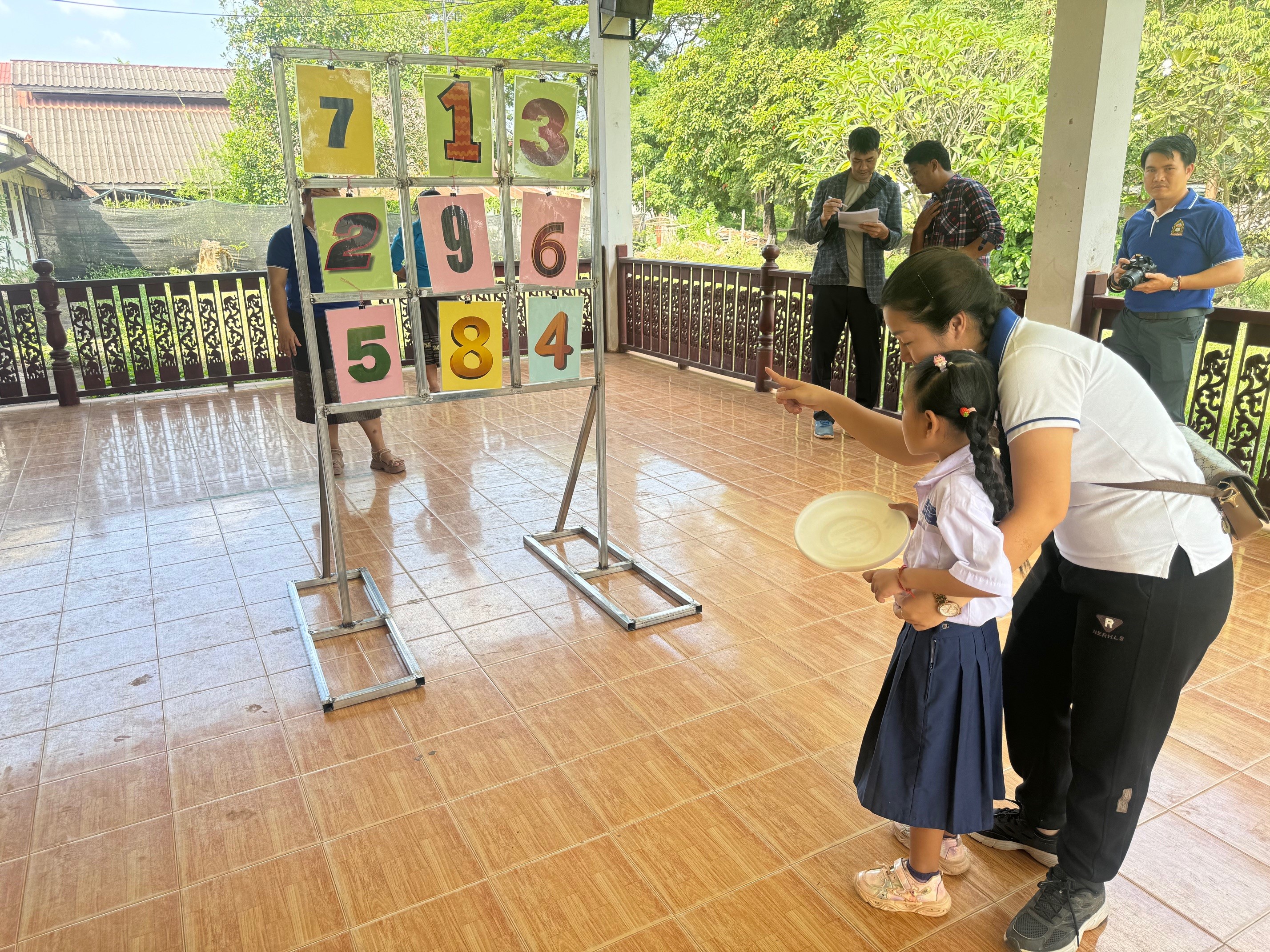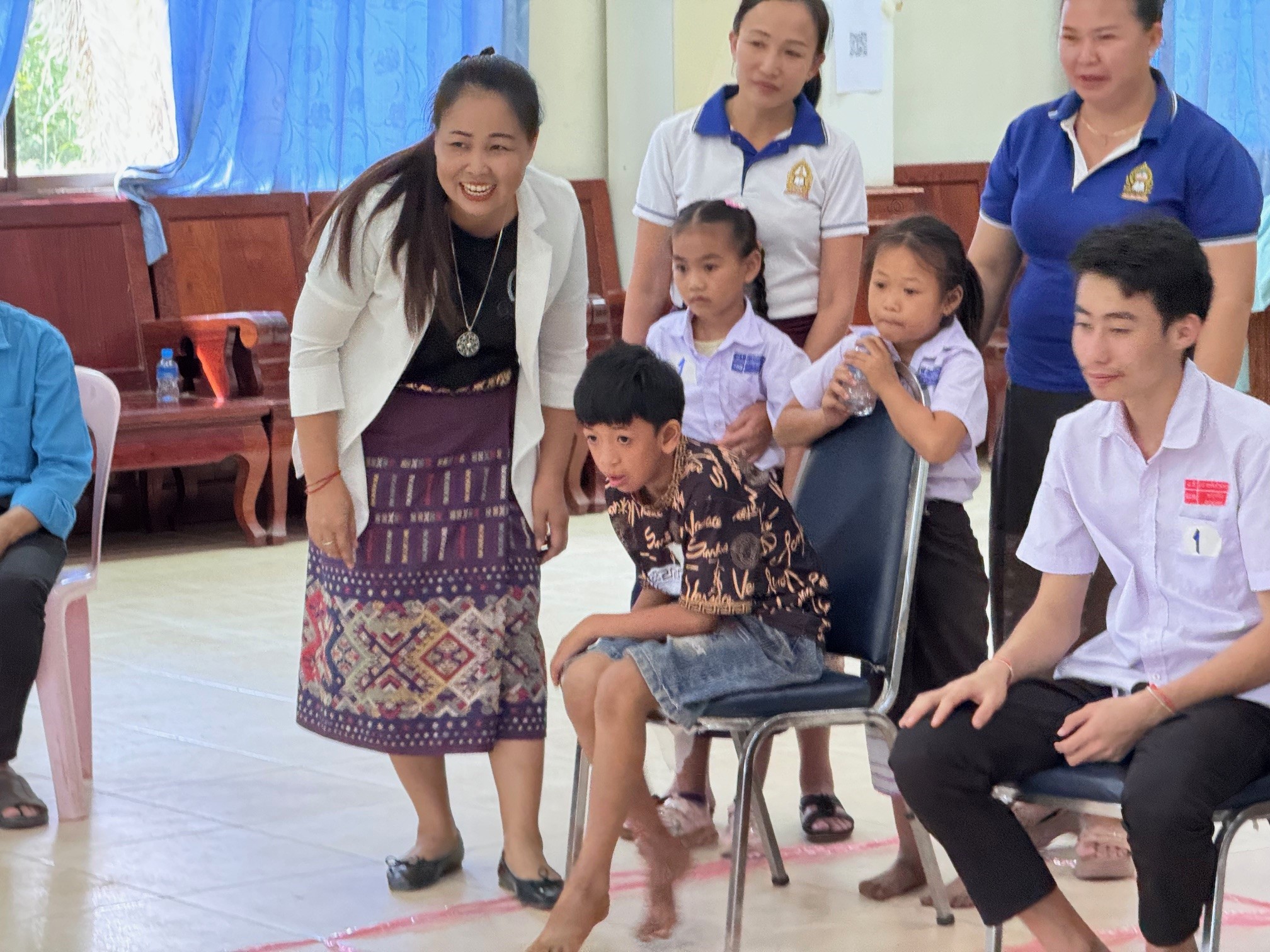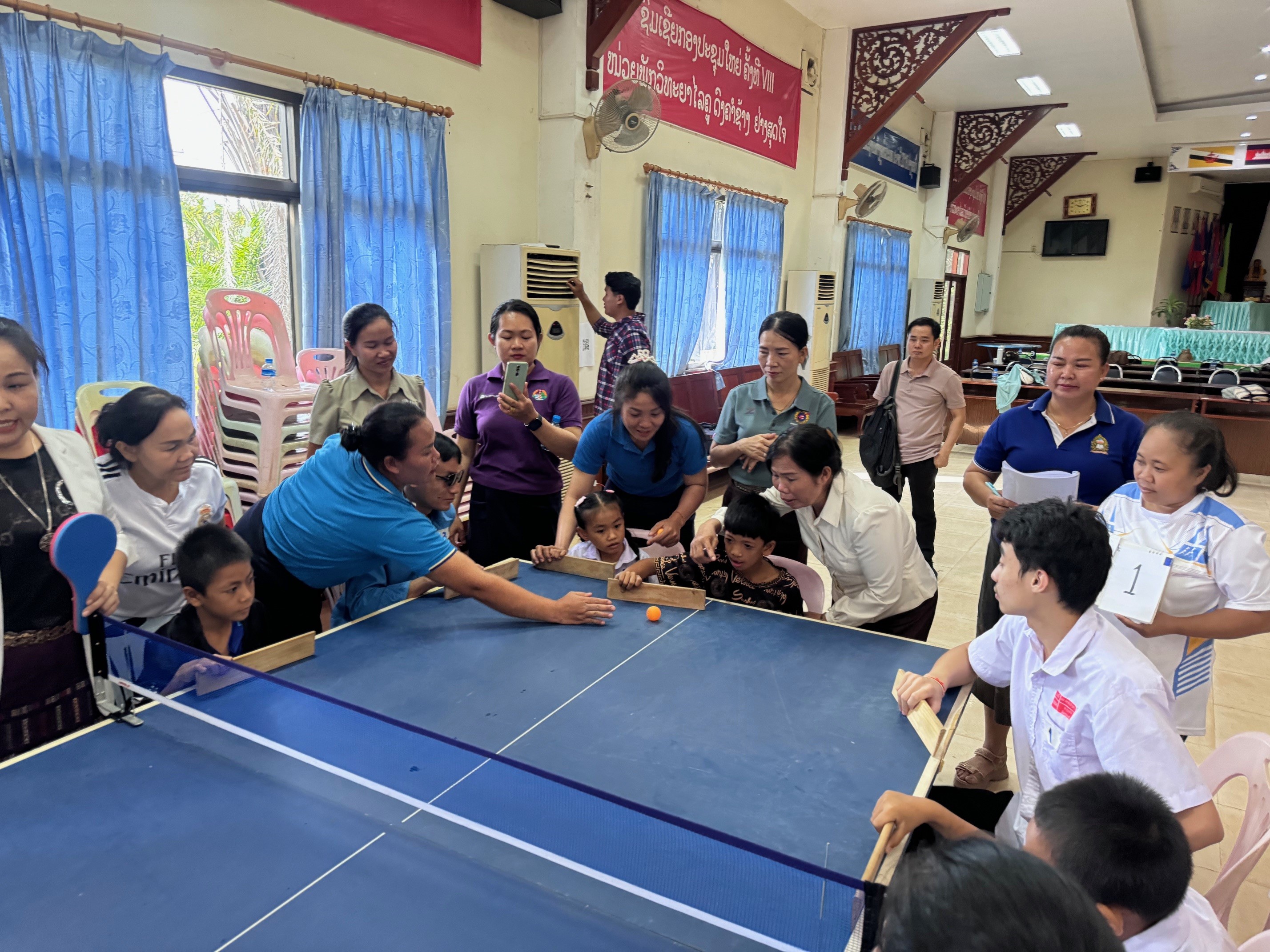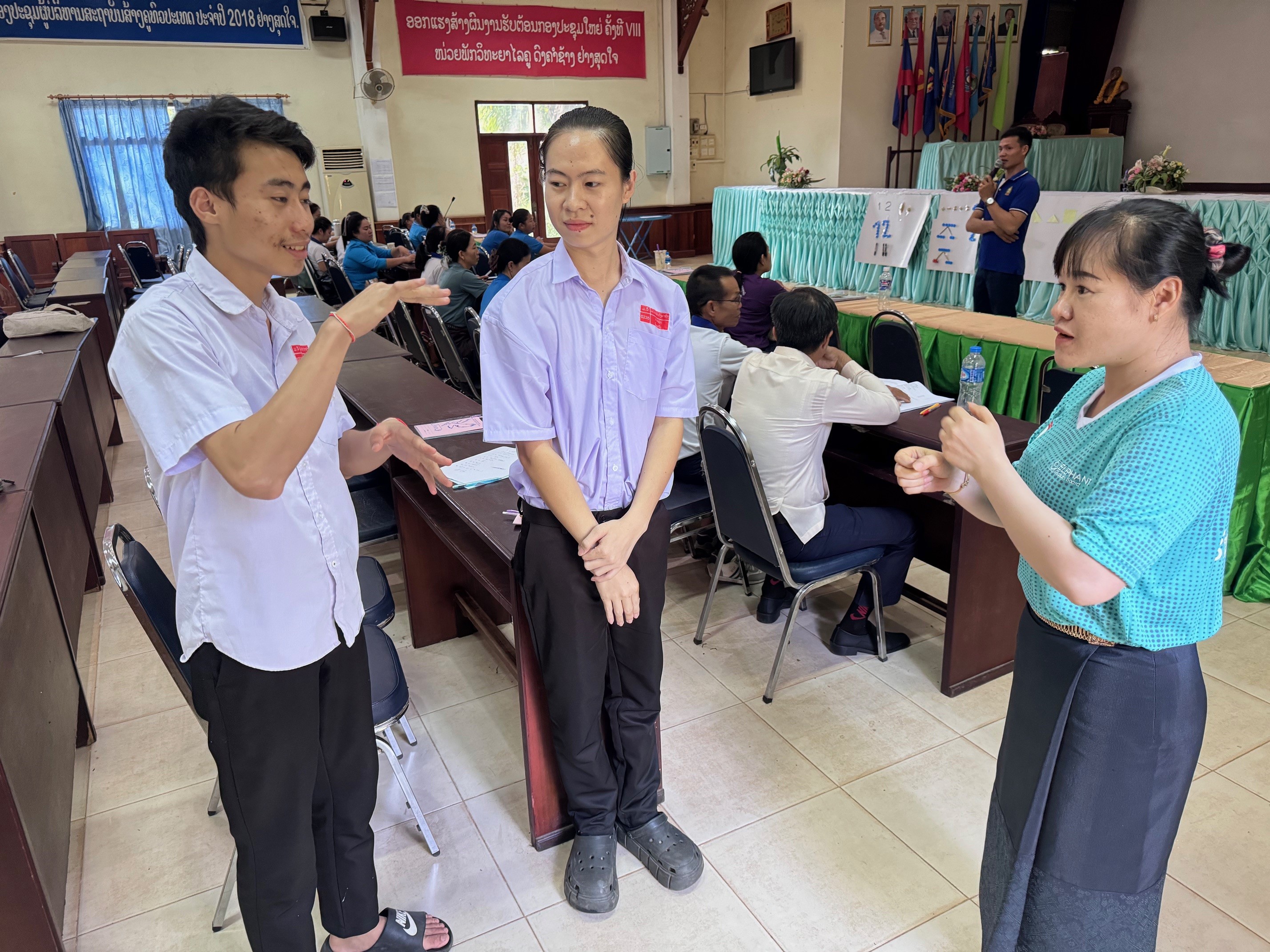Table of Contents
- 1 Current teachers learned about inclusive education at a school affiliated with Donkamsah Teacher Training College
- 2 Implementation of a “mock class” to summarize the training
- 3 Everyone enjoyed universal sports regardless of their disability!
- 4 The birth of supervisors for the inclusive education teacher training course and future challenges
- 5 How effective do you think universal sports are in promoting inclusion among children with and without disabilities in schools?
A current teacher’s passionate desire to include children with disabilities in her class.
Current teachers learned about inclusive education at a school affiliated with Donkamsah Teacher Training College
The Association for Supporting Activities of Persons with Disabilities in Asia (hereinafter referred to as ADDP), a specified non-profit organization, is currently conducting a JICA grassroots technical cooperation project in Laos called “Inclusive education and employment aimed at social independence for children with intellectual and developmental disabilities”. We are currently implementing the “Support Practice” project. One of the goals of this project, with teacher training schools as counterparts, is to enable regular teachers at model schools to practice inclusive education, including support for the transition from education to employment.
*Inclusive education is education that aims to realize a cohesive society in which all children learn together in the same environment, regardless of the presence or absence of disabilities such as intellectual/developmental disabilities, hearing impairments, visual impairments, or individual characteristics. is.
For five days from October 21st to 25th, we held an inclusive education teacher training workshop for teachers from schools affiliated with Donkhamsar Teacher Training College (TTC). With TTC affiliated elementary schools now accepting children with disabilities, there was a request from Donkumsar TTC for teachers at affiliated schools to learn more about inclusive education, and TTC affiliated kindergartens, elementary schools, and junior high schools This workshop will be held for a total of 20 teachers.
In this training, TTC supervisors gave lectures on the educational needs and teaching methods of various disabilities such as intellectual/developmental disabilities, visual disabilities, hearing disabilities, and physical disabilities, as well as the development of IEPs (Individualized Educational Support Plans). I also taught.
Teachers and children from a school affiliated with Don Kamsar Teacher Training School who participated in the inclusive education teacher training workshop
Implementation of a “mock class” to summarize the training
As a summary of the five-day training, teachers from affiliated schools who participated in the training held a mock class at Parsay Elementary School, which practices inclusive education.
Parsay Elementary School is a public school that accepts a wide variety of children, regardless of their grade level or the presence or absence of disabilities, and allows them to learn together. In this mock class, children with intellectual disabilities, developmental disabilities, and visual impairments also participated, and the teachers put into practice the teaching methods they had learned. For children who were unable to keep up with the lessons, the teachers prepared questions and teaching materials that matched the child’s level of understanding, and worked to prevent the child from giving up on learning. Additionally, in order for everyone to have fun working together, we implemented team activities and used group presentations so that everyone could feel a sense of accomplishment together.
Through this mock class, teachers were able to learn practically about how to provide education in which all children, regardless of whether they have a disability or not, can participate with confidence.
ADDP project coordinator Takahisa Arai had the following to say about this five-day training course:
“It was very encouraging to see teachers plan and prepare mock lessons themselves and provide a learning environment that everyone can enjoy.Inclusive education does not just accept children, but brings out the potential of each child. It is important to constantly think about what measures are needed to achieve this goal.I am confident that through this training, the teachers were able to take the first step.
The mock class at Parsay Elementary School provided a valuable opportunity for teachers to deepen their practical skills in inclusive education, and we hope that the affiliated schools will further promote inclusive education in the future.
A mock class at Parsay Elementary School. Everyone smiles during group work!
Everyone enjoyed universal sports regardless of their disability!
On the third day of this five-day training session, we learned about universal sports. Of course it is important to acquire knowledge about various disabilities such as visual impairments and developmental disabilities, but it is also very important to have fun together through sports and spend time together, regardless of whether you have a disability or not. . Children with suspected developmental disabilities, high school students with hearing impairments, and teachers with visual impairments also participate in this universal sports training, which aims to ensure that children with any disabilities can enjoy sports together. I learned it firsthand.
On this day, we practiced three types of sports: flying disc, boccia, and table tennis volleyball. Of these, boccia and table tennis volleyball are widely known as universal sports. Table tennis volleyball is a universal sport that originated in Japan, and boccia is also a Paralympic sport. All sports are designed so that everyone can enjoy them together, regardless of whether they have a disability, and it is hoped that they will be incorporated into school education in Laos.
Teachers from the affiliated schools who participated learned that even people with disabilities can have fun together by making creative efforts and providing support. In particular, with regard to “support,” the teachers at the affiliated schools were thinking individually about how much support they should provide. For example, in table tennis volleyball, the sound is produced by the small balls inside the ball. Visually impaired people may be able to rely on the sound and enjoy the game without any support, while other times they may need to use their hands for support while swinging the racket while saying things like “Here’s the ball!”. I supported them while exploring various possibilities, such as leaving it to the person himself or offering some help.

Flying Disc: Small children and teachers formed teams and competed for points.

Boccia: Everyone is looking serious! This is a brain play in which the team works together to decide where to throw the ball.

Table tennis volleyball: There are balls inside the ball, so visually impaired people could enjoy it along with the sound.
*About flying discs
About the competition | Japan Disabled Flying Disc Federation
*What is Boccia?
What is Boccia? | Japan Boccia Association
*What is table tennis volleyball?
What is table tennis volleyball? – Japan Table Tennis Volleyball Federation Official Homepage
The birth of supervisors for the inclusive education teacher training course and future challenges
Participants said, “Up until now, there were children with disabilities in my class, but I had not had the opportunity to learn about them, so this was a great opportunity for me” and “Parasports are a great way for everyone to enjoy together, regardless of whether they have a disability or not.” Opinions such as “Now that I know what I can do, I want to put it into practice” and “I have come to believe that schools need to accept children with disabilities” were expressed.
On the other hand, the following comments were also heard: “I am a first-grade elementary school teacher, and I am in charge of over 50 children, including four with disabilities.Even children without disabilities still have difficulty sitting calmly and listening to the lessons. It’s really difficult to accommodate multiple children with developmental disabilities.I think inclusive education is important, so I would like them to somehow divide the class into two or add an assistant teacher.”In Laos, budgets are limited. There is currently a shortage of teachers. Although it is difficult to solve this problem, ADDP is consulting with Donkhamsar Teacher Training College to explore the possibility of allowing students from the teacher training school to become assistant teachers.
Through this training, teachers from kindergartens, elementary schools, and junior high schools affiliated with Donkhamsar Teacher Training School learned about inclusive education. This affiliated school is called “Sahthit” school in Lao, and “Sahthit” means “to set an example.” This time, it is hoped that the teachers at the affiliated school will learn about inclusive education and put it into practice at the affiliated school, thereby serving as a model for other schools and spreading inclusive education to other schools.

Mr. Kampan, a supervisor at Don Kamsar Teacher Training School, communicates with deaf students using sign language.
Go to list page

How effective do you think universal sports are in promoting inclusion among children with and without disabilities in schools?
The article discusses a training course on inclusive education for teachers from affiliated schools conducted by the Japanese International Cooperation Agency (JICA) in Laos. The course was attended by various teachers, including those who worked with kindergarten, elementary, and junior high school-aged children. Through the training, the participants learned about different aspects of inclusive education, including how to accommodate children with disabilities in their classes and engage them effectively. They also had a chance to practice what they learned during a ”mock class” at a school that practices inclusive education. Additionally, the training covered universal sports, which can be enjoyed by everyone regardless of disability. After the training, participants expressed interest in implementing the knowledge they gained, but some expressed concern about managing children with disabilities in large classes. The article also mentions the goal of having the participating teachers act as models for inclusive education in their respective affiliated schools and eventually expanding it to other schools in the area.
1. What are your thoughts on inclusive education? Do you believe it should be implemented in all schools?
2. How can teachers create an inclusive classroom environment for children with disabilities and those without?
3. Can you share your experiences or any challenges you faced while teaching children with disabilities before attending this training course?
4. What was the most valuable lesson you learned from the training course on inclusive education?
5. Do you think it is necessary to have separate classes or activities for children with disabilities or should they be integrated into mainstream education?
6. How can we address the issue of budget constraints and limited resources when implementing inclusive education in schools?
7. What role do you think teacher training programs like this play in promoting inclusive education in developing countries?
8. Can you describe a specific activity you participated in during the “mock class” and how it helped you understand the importance of inclusive education?
9. How can teachers ensure that children with disabilities are not left behind in large classes with limited resources?
10. What are your future plans for promoting inclusive education in your school or community after attending this training course?
